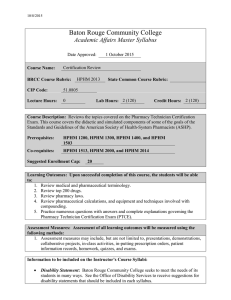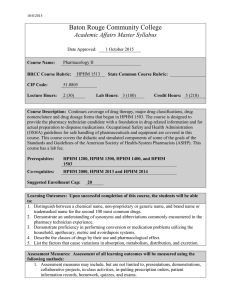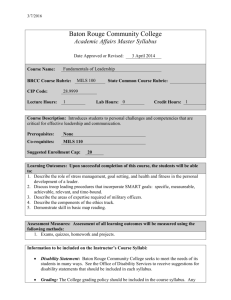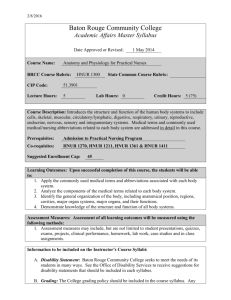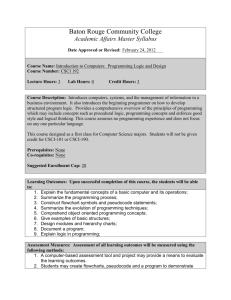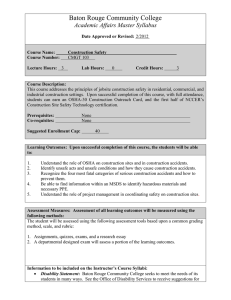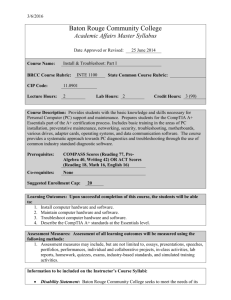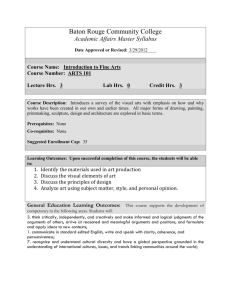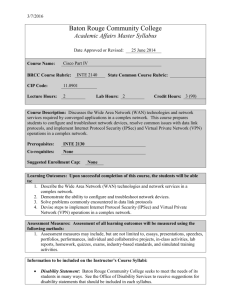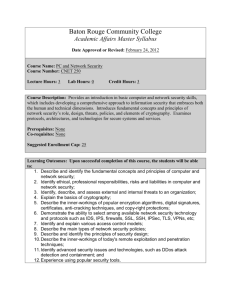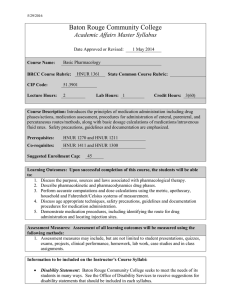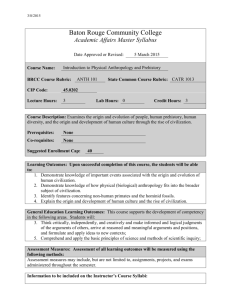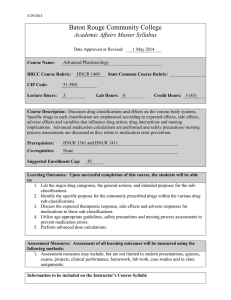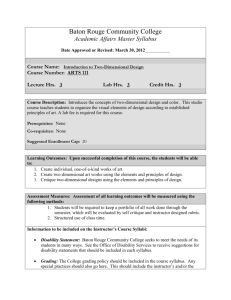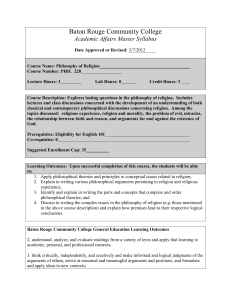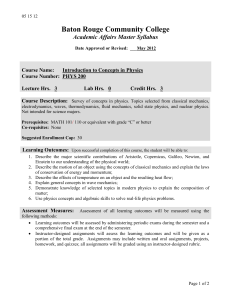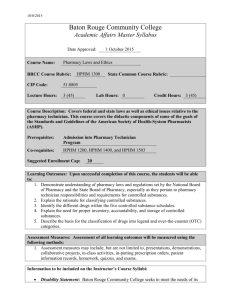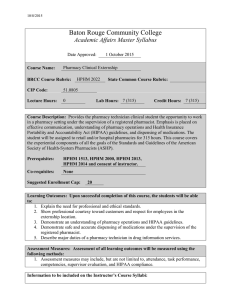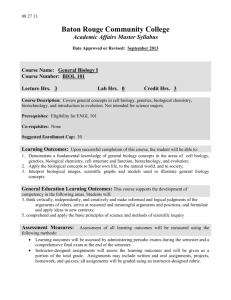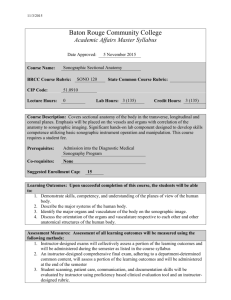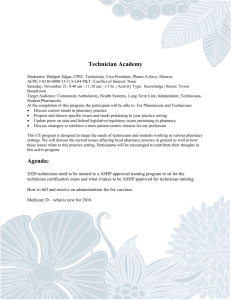HPHM_1503_MS - Baton Rouge Community College
advertisement
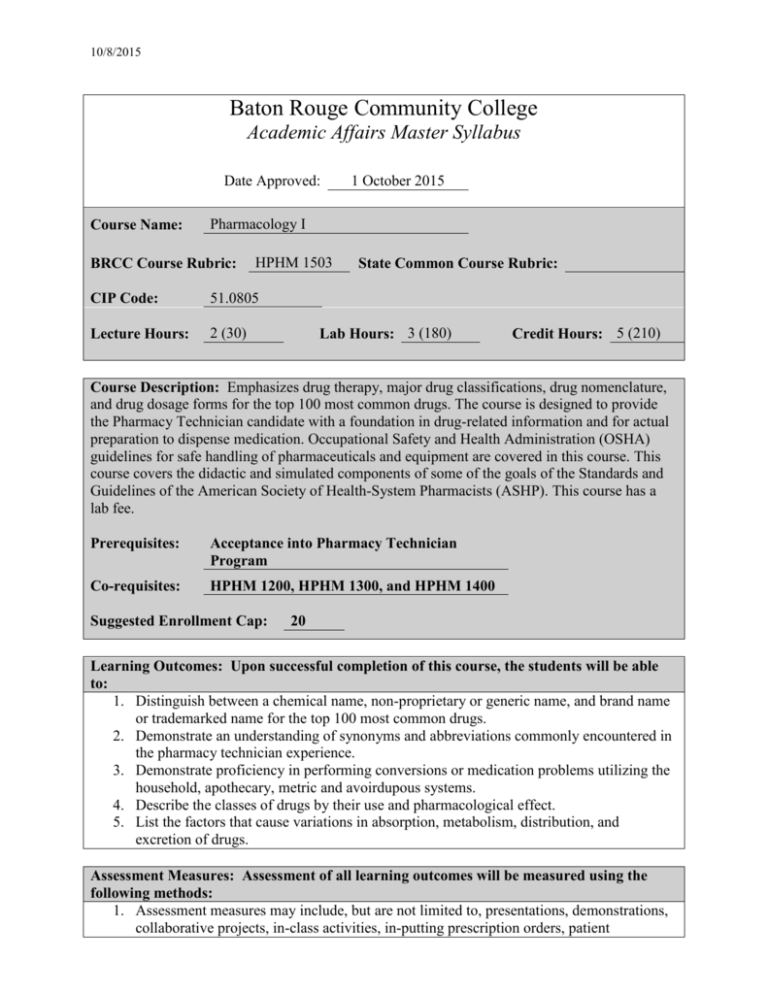
10/8/2015 Baton Rouge Community College Academic Affairs Master Syllabus Date Approved: Course Name: 1 October 2015 Pharmacology I BRCC Course Rubric: HPHM 1503 CIP Code: 51.0805 Lecture Hours: 2 (30) State Common Course Rubric: Lab Hours: 3 (180) Credit Hours: 5 (210) Course Description: Emphasizes drug therapy, major drug classifications, drug nomenclature, and drug dosage forms for the top 100 most common drugs. The course is designed to provide the Pharmacy Technician candidate with a foundation in drug-related information and for actual preparation to dispense medication. Occupational Safety and Health Administration (OSHA) guidelines for safe handling of pharmaceuticals and equipment are covered in this course. This course covers the didactic and simulated components of some of the goals of the Standards and Guidelines of the American Society of Health-System Pharmacists (ASHP). This course has a lab fee. Prerequisites: Acceptance into Pharmacy Technician Program Co-requisites: HPHM 1200, HPHM 1300, and HPHM 1400 Suggested Enrollment Cap: 20 Learning Outcomes: Upon successful completion of this course, the students will be able to: 1. Distinguish between a chemical name, non-proprietary or generic name, and brand name or trademarked name for the top 100 most common drugs. 2. Demonstrate an understanding of synonyms and abbreviations commonly encountered in the pharmacy technician experience. 3. Demonstrate proficiency in performing conversions or medication problems utilizing the household, apothecary, metric and avoirdupous systems. 4. Describe the classes of drugs by their use and pharmacological effect. 5. List the factors that cause variations in absorption, metabolism, distribution, and excretion of drugs. Assessment Measures: Assessment of all learning outcomes will be measured using the following methods: 1. Assessment measures may include, but are not limited to, presentations, demonstrations, collaborative projects, in-class activities, in-putting prescription orders, patient information records, homework, quizzes, and exams. Information to be included on the Instructor’s Course Syllabi: Disability Statement: Baton Rouge Community College seeks to meet the needs of its students in many ways. See the Office of Disability Services to receive suggestions for disability statements that should be included in each syllabus. Grading: The College grading policy should be included in the course syllabus. Any special practices should also go here. This should include the instructor’s and/or the department’s policy for make-up work. For example in a speech course, “Speeches not given on due date will receive no grade higher than a sixty” or “Make-up work will not be accepted after the last day of class.” Attendance Policy: Include the overall attendance policy of the college. Instructors may want to add additional information in individual syllabi to meet the needs of their courses. General Policies: Instructors’ policy on the use of things such as beepers and cell phones and/or hand held programmable calculators should be covered in this section. Cheating and Plagiarism: This must be included in all syllabi and should include the penalties for incidents in a given class. Students should have a clear idea of what constitutes cheating in a given course. Safety Concerns: In some programs this may be a major issue. For example, “No student will be allowed in the safety lab without safety glasses.” General statements such as, “Items that may be harmful to one’s self or others should not be brought to class.” Library/ Learning Resources: Since the development of the total person is part of our mission, assignments in the library and/or the Learning Resources Center should be included to assist students in enhancing skills and in using resources. Students should be encouraged to use the library for reading enjoyment as part of lifelong learning. Expanded Course Outline: 1. Definitions of key terms related to pharmacology, pharmacokinetics and therapeutic equivalence. (Goal 9). 2. Disease conditions affecting body systems and drug classifications that are utilized to treat the various conditions. (Goal 11). 3. Interpreting and processing prescriptions. (Goals 18, 21, 25, 31, 41). 4. Drug recalls, lot numbers and expiration dates. (Goal 20). 5. Infection control procedures and Occupational Safety and Health Administration (OSHA) guidelines. (Goal 22). 6. Reconstituting powdered medication and calculating desired dosages using the Biological Safety Cabinet. (Goals 22, 29). 7. Using formulas to calculate and prepare intravenous fluid administration rates (IV) using the Biological Safety Cabinet. (Goals 26, 28). 8. Material Safety Data Sheets (MSDS) and chemotherapeutic agents. (Goal 27). 2 9. Continuing education and expanding roles of pharmacy technicians. (Goals 8, 10, 13, 15). 3
